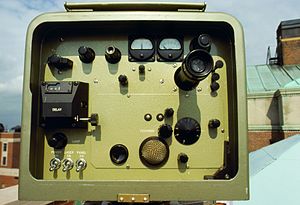
The Geodimeter (acronym of geodetic distance meter) was the first optical electronic distance meter surveying instrument. It was originally developed for measuring the speed of light. It was invented in 1947 by Erik Osten Bergstrand [sv] and commercialized in 1953 by the AGA (Aktiebolaget Gasaccumulator) company of Sweden. It was used in the Transcontinental Traverse.
The Geodimeter business was acquired by SpectraPrecision which was acquired by Trimble Inc.
Electronic mechanism
The mechanism uses a Kerr cell in an optical train that chops a collimated beam of light under the control of a precision electronic oscillator in the megahertz range. It is similar in principle to the mechanical chopper in Fizeau's measurement of the speed of light in air that used a toothed wheel.
See also
References
- Rüeger 2012, p. 15.
- Bergstrand 1952.
- Froome & Essen 1969.
- Bergstrand 1950.
- Laurila 1960, p. 194.
- "AGA Geodimeter". AGA Museum. 2014-10-03. Retrieved 2020-09-24.
- Poling 1959.
- "EDM (Geodimeter Model 2A)", Database: Physical Sciences Collection - Surveying and Geodesy, Smithsonian Institution, 4 August 2015, catalog number 1998.3094.01, retrieved 2018-05-02
Sources
- Bergstrand, Erik (1950). "Velocity of Light". Nature. 165 (4193). Springer Science and Business Media LLC: 405. Bibcode:1950Natur.165..405B. doi:10.1038/165405a0. ISSN 0028-0836. S2CID 4281189.
- Bergstrand, Erik (1952). "Distance measuring by means of modulated light". Bulletin Géodésique. 24 (1): 243–249. Bibcode:1952BGeod..26..243B. doi:10.1007/BF02526937. ISSN 0007-4632. S2CID 121587208.
- Poling, Austin C. (1959). Geodimeter Manual. U.S. Coast and Geodetic Survey. Publication 62-2.
- Laurila, Simo (1960), "Geodimeter", Electronic Surveying and Mapping: Part 1, Fundamentals of Electronic Surveying, Institute of Geodesy, Photogrammetry and Cartography, The Ohio State University, pp. 194–203, hdl:2027/uiug.30112007333120, OCLC 58011617, retrieved May 6, 2021 – via HathiTrust
- Froome, K.D.; Essen, L. (1969). The Velocity of Light and Radio Waves. Academic Press. ISBN 9780122428500. Retrieved 2020-09-24.
- Rüeger, J.M. (2012). Electronic Distance Measurement: An Introduction. Springer Berlin Heidelberg. p. 15. ISBN 978-3-642-80233-1. Retrieved 2020-09-24.
Further reading
- Poling, Austin C. (April 1958), "The Geodimeter and Tellurometer", Journal of the Surveying and Mapping Division, 84 (1), American Society of Civil Engineers, doi:10.1061/JSUEAX.0000024
- Rimington, George Robert Lindsay (March 1956), "Introduction to the Geodimeter", Cartography, 1 (3): 120–124, archived from the original on 2015-06-29 – via Pandora Archive
{{citation}}: CS1 maint: date and year (link) - Smith, J.R. (1998), The History of Geodimeter (PDF), Sweden: Spectra Precision, 07-98 Publ. No. 571 710 000
- Wise, Paul (2014), NATMAP's Introduction of Electronic Distance Measuring to Australia - Sixty Years On, Government of Australia, archived from the original on 2018-02-26 – via Pandora Archive
{{citation}}: CS1 maint: bot: original URL status unknown (link)
External links
- AGA Geodimeter Model 6 (Going the Distance: A Photo Collection Illustrating the History of Distance Measurement Tools at the National Geodetic Survey)
This standards- or measurement-related article is a stub. You can help Misplaced Pages by expanding it. |
This geodesy-related article is a stub. You can help Misplaced Pages by expanding it. |